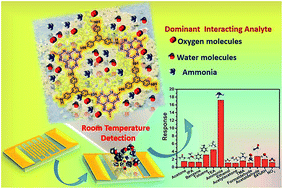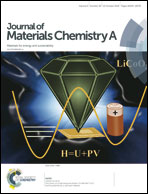Heptazine based organic framework as a chemiresistive sensor for ammonia detection at room temperature†
Abstract
The demand for high performance gas sensors in IoT applications is of great interest. Gas sensors with high sensitivity and selectivity at room temperature have been expected for practical applications. However, the limitations of conventional metal oxide based sensing materials and unstable outputs caused by ambient environments significantly restrict their practical applications. Herein, we have demonstrated for the first time a heptazine based microporous polymer sensor for the detection of ammonia at room temperature and under ambient conditions. The chemiresistive sensor performance for ammonia was investigated over a wide concentration range (1–200 ppm) and in the presence of a relative humidity range (23–85% RH). The presence of active sites (C![[double bond, length as m-dash]](https://www.rsc.org/images/entities/char_e001.gif) N and NH groups) and the porous network of a heptazine gas sensor enables an enhanced response (16.6 at 70% RH and 47 at 84% RH) towards 50 ppm of ammonia with response and recovery times of 65 and 9 s, respectively. The electron withdrawing nature of heptazine enables better selectivity towards ammonia over other VOC analytes. Therefore, we believe that the developed sensing material presents an excellent opportunity for the development of high performance, portable, easy-to-use devices for disease diagnosis via breath analysis and environmental monitoring under ambient conditions.
N and NH groups) and the porous network of a heptazine gas sensor enables an enhanced response (16.6 at 70% RH and 47 at 84% RH) towards 50 ppm of ammonia with response and recovery times of 65 and 9 s, respectively. The electron withdrawing nature of heptazine enables better selectivity towards ammonia over other VOC analytes. Therefore, we believe that the developed sensing material presents an excellent opportunity for the development of high performance, portable, easy-to-use devices for disease diagnosis via breath analysis and environmental monitoring under ambient conditions.



 Please wait while we load your content...
Please wait while we load your content...